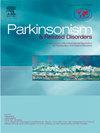Association of patient characteristics, social drivers of health, and geographic location on access to device-aided therapies among medicare beneficiaries with advanced Parkinson's disease
IF 3.1
3区 医学
Q2 CLINICAL NEUROLOGY
引用次数: 0
Abstract
Introduction
Surgical device-aided therapies (DATs), including carbidopa-levodopa enteral suspension (CLES) and deep brain stimulation (DBS), are efficacious treatment options for people with advanced Parkinson's disease (aPD). While provider and patient preference influence treatment choices, DAT use remains low and social drivers of health (SDOH) may present barriers to access. This study aimed to evaluate the relationship of patient characteristics and SDOH—including geographic distance to facilities that provide DATs—with likelihood of receiving DAT.
Methods
Adults diagnosed with PD and meeting aPD clinical indicators were identified among 100 % Medicare Fee-for-Service beneficiaries linked to Inovalon's SDOH data warehouse between 01/01/2018-12/31/2020. Multivariate logistic regression models determined factors associated with DAT vs no-DAT initiation.
Results
Of 503,245 Medicare beneficiaries with PD, 22 % met proxy criteria for aPD, with 2 % (2450) receiving DAT (CLES 24 %; DBS 76 %). Nationwide aPD prevalence was 309 per 100,000 Medicare beneficiaries. There were 413 DAT facilities nationwide (average 8 facilities/state), and aPD patients traveled 98 miles on average to a facility (range 11–255 miles). aPD patients under age 75 were 2-3x more likely to receive DAT, while those identifying as female, Black race, have moderate to severe comorbidity, and lower household incomes were less likely to receive DAT.
Conclusions
Findings suggest low utilization of DATs among US Medicare beneficiaries with aPD. Even states with more DAT facilities often require patients to travel long distances. Identifying and minimizing access disparities, particularly for women, racial minorities, and people with low socioeconomic status may improve DAT utilization and outcomes for patients with aPD.
求助全文
约1分钟内获得全文
求助全文
来源期刊

Parkinsonism & related disorders
医学-临床神经学
CiteScore
6.20
自引率
4.90%
发文量
292
审稿时长
39 days
期刊介绍:
Parkinsonism & Related Disorders publishes the results of basic and clinical research contributing to the understanding, diagnosis and treatment of all neurodegenerative syndromes in which Parkinsonism, Essential Tremor or related movement disorders may be a feature. Regular features will include: Review Articles, Point of View articles, Full-length Articles, Short Communications, Case Reports and Letter to the Editor.
 求助内容:
求助内容: 应助结果提醒方式:
应助结果提醒方式:


